Correct care for acalifa at home. Acalifa or Fox Tail: Home Care
To print
Svetlana Mitrofanova 09/29/2014 | 4230.
Flowers of this exotic plant resemble fluffy lisus tail. It is because of this similarity of acalifa and received its second name. The plant feels good in the tropics and subtropics, so the question arises: how to grow it at home?
Acalifa refers to shrub plants growing in New Guinea and Malaysia. "Fox's tail" - single-season plantBut under comfortable conditions, the flower can survive 3-5 winters. Leaves Acalifa resemble nettle: the same pointed and pubescent. Their length typically reaches 25 cm. The adult plant grows in a height of up to 80 cm. Flowers Small size and assembled in lower inflorescences-earrings. Blossom Acalifa continues from the beginning of the spring and to autumn.
Care for acalifa
Tropical acalifa prefers bright lightingbut take a pot under direct sun rays Do not. The lack of light is instantly affected by the state of the plant. Weak flowering and loss of bright coloring indicate incorrect care. Temperature mode For acalifes during the year, it should be approached in the summer. The optimal temperature is from 22 to 24 ° C, in winter - at least 17 ° C. Acalifa follows frequently spraySince the plant loves high air humidity. To do this, you can also place acalifu in the pallet filled with moss or clay.
Watering and feeding
In the warm, acalifa requires abundant glaze, But with the onset of cold, the intensity should be reduced by the amount. Water should be so much that the earthen com always remained slightly wet. From March to October, the plant needs undercumbers. Once in a half months should be added to the soil acalifa organic or mineral fertilizers. In winter, fertilizers should not be made, as the plant is at this time at rest.
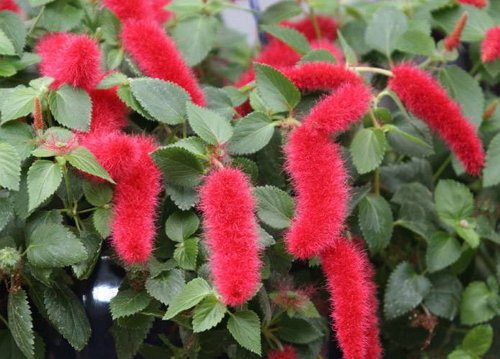
Soil and transplant
The plant transplantation should be carried out every year in spring time. Adult plants can be replanted not more than once every three years. For landing, acalifa is suitable light air- and water permeable Soil mixtureconsisting of sheet and turf, peat and sand.
To save a plant from degeneration, in February it is necessary to break the acalifa. On the maternal bush should leave branches up to 25 cm long - then the "fox tail" will begin to actively close. At the same time, it is possible to draw a stalling of the plant, rooting the cropped shoots. It is also possible to propagate the acalifu, with the help of air cuttings, gods and seeds.
Possible problems
- The main enemies acalifa are tLL, COLUTIN CLEAN AND BLOCK. The sign of the disease of the plant is the appearance of spots on the leaves.
- Faded leaves are a sign cutting off earth koma, or on the contrary, movement.
- Highly "Heavy" substrate Or unstable irrigation can lead to a deterioration in plant growth.
- Loss of coloring and pallor leaves may occur from lack of lighting. If the plant was in a shaded place, then it is impossible to immediately carry it on a brightly illuminated place. In winter, acalifu needs to additionally highlight with fluorescent lamps.
Acalifa immediately attracts attention to unusual spectacular inflorescences similar to the birch "serving". Bright colors - scarlet, Punchy, snow-white - beneficially stand out against the background of gentle-salad leaves. The birthplace of acalifes - tropics, but she surprisingly adapted to the microclimate of modern apartments, very different from the conditions familiar to it. Even the novice flower breeder can grow these "tails" - the care of the plant at home is quite simple.
What does acalif look like?
In the nature of the acalifa is a shrub tall of about 2 m, dimensions indoor plants Much modest
Akalifa (Acalypha), she is "fox tail" or "cat tail" - the genus of evergreen grassy plants and shrubs (very rarely - low trees), belonging to the family of the Muphorny (Euphorbieae), numbering about 450 representatives. Its name comes from ancient Greek "nettle" and is due to the external similarity of the leaves. They are really easy to confuse - similar shape (ovoid, with a pointed tip and carved triangular closights), and color. The presence of rare thin bristles is also characteristic of the well-known weed. Some less often at home there are other acalifes - they are less effectively blooming, but the leaves have an unusual bronze or copper tide, covered with dark-alay spots.
 Even the unconcerning acalifa looks elegant thanks to bright greenery
Even the unconcerning acalifa looks elegant thanks to bright greenery Motherland Acalifa - Tropics. The most common plant in Southeast Asia, Australia, on the islands between these continents. Separate species are found in South and North America.
Like other people, the acalifa poisonous. All parts of the plant contain caustic milk-white juice, strongly irritating skin and even stronger - mucous membrane. In particularly severe cases, even allergic reactions of the type of qquinke are possible. Any flower work is carried out only in gloves. Having finished, be sure to wash your hands. Also pick up such a place where small children and pets will be able to get there.
Acalifa, as often happens - not only poison, but also medicine. This is due to the presence of specific alkaloids and glycosides. Australia and Polynesia Aborigines use a plant for the treatment of lung diseases (bronchitis, pneumonia, asthma) and the gastrointestinal tract. It has been scientifically proven that she, highlighting phytoncides, purifies the ambient air from pathogenic bacteria - staphylococci, streptococci.
The main value of acalifes in the eyes of a flower plant is the spectacular inflorescences of the accositate form. In nature, their length reaches 50 cm, at home is 30 cm. It is bright beautifully falling shaggy brushes in vivo hold on the plant for several months. "In the capture" plant blooms even more worst, almost continuously, at least since the end of winter until the middle of the autumn.
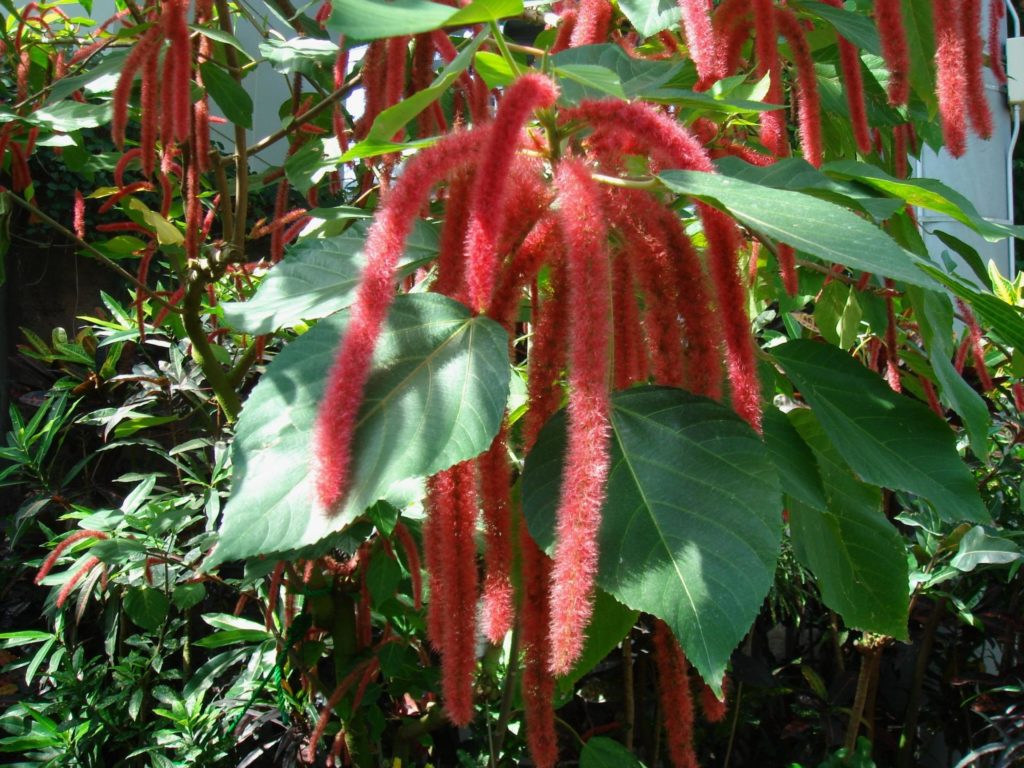 Blooming acalifa with proper care pleases the eye for almost all year
Blooming acalifa with proper care pleases the eye for almost all year
The undoubted dignity of the flower is compact. In the nature of the acalifa, it can grow up to 2 m high, at home is rarely above 50-70 cm.
Astrologers and adherents of the Fengshui teachings appreciate the Acalifa for the support that she has the heart, keeping the "light" atmosphere in the house and the cheerfulness of its owners. It is believed that the flower accumulates positive energy and at the right moment is divided by it with the owners, supporting cheerfulness and optimism in them. He also softens harsh men, and women, on the contrary, adds the strength of the Spirit and Will.
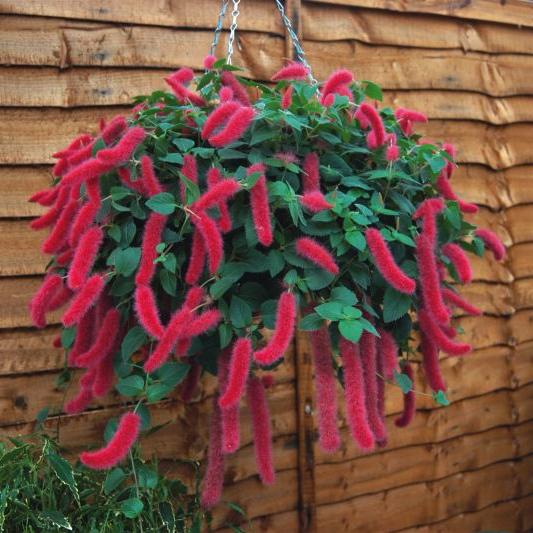 Acalif looks good not only on the windowsill, but also in suspended porridge
Acalif looks good not only on the windowsill, but also in suspended porridge
Video: Appearance Acalifa
Popular varieties grown at home
To the household conditions adapted quite a few types of acalifes. There are selection hybrids. The most popular in flower water:
- Akalif Wilxa (Wilkesiana). A bush plant, reaching a height of 1 m. Soothes have copper-red shades covered with rare villi. The length of the sheet is about 20 cm, the width is 15 cm. Flowers pretty nondescript, the amount of inflorescences - up to 8-10 cm. Bronze leaves are covered with copper or pink-red spots. Selection hybrids - Mosaica (brown-red leaves covered with yellow-red, terracotta and bronze wide strokes) and Marginata (olive-brown leaves with Punchy border).
- Acalifa bristle-free (Hispida). Very bright green leaves and large (35-40 cm long) scarbon or raspberry inflorescence. At the alba selection hybrid, they are snow-white. The first type of acalifa, which began to be widely grown at home.
- Akalif Indian (Indica). Height - no more than 0.5 m, the branching is weak. The tops of the stalks are strongly pubescent. The length of the sheet is 4-6 cm. Its foundation is clearly distinguished by 5 residences. Flowering short - from mid-summer before the start of spring. The inflorescences "hide" in the sinuses of the leaves.
- Acalifa South (Australis), sometimes not quite referred to as "Australian". The height of the bush plant is 45-50 cm, the ribbed shoots covered with rare hard hairs are intensively branched. The length of a very thin sheet - 4-5 cm. Flowers not long - July, August. The inflorescences are stylish.
- Acalifa Dubravutant (Chamaedrifolia), she is also Haitian (Hispaniolae). Low thump shrub. Heat-shaped leaves (length 3-4 cm) very tender light green. Self-detention facilities 4-10 cm. At home is often grown by an ampel solution. If you take a fairly wide pot, take the soil with a solid carpet.
- Acalifa Godseffiana. Selection hybrid. The leaves in the form of a wide oval up to 20 cm long, densedly flooded. Greens casting bronze where straight sun rays fall on it, becomes copper-red or golden. Akalifa Godsefa is a divided (HETEROPHYLLA), grown in bright lighting of any origin, changes the color of the leaves on the scarlet.
- Akalifa California (Californica). It has an atypical agalifa place of growth. Salad leaves, with large cloths. Inflorescences bright pink.
Photo Gallery: South Akalif, Wilks, bristle-free and other varieties
 Wilx Acalifa at home is most often the selection variety of Mosaica is characterized by very elegant coloring leaves.
Wilx Acalifa at home is most often the selection variety of Mosaica is characterized by very elegant coloring leaves. 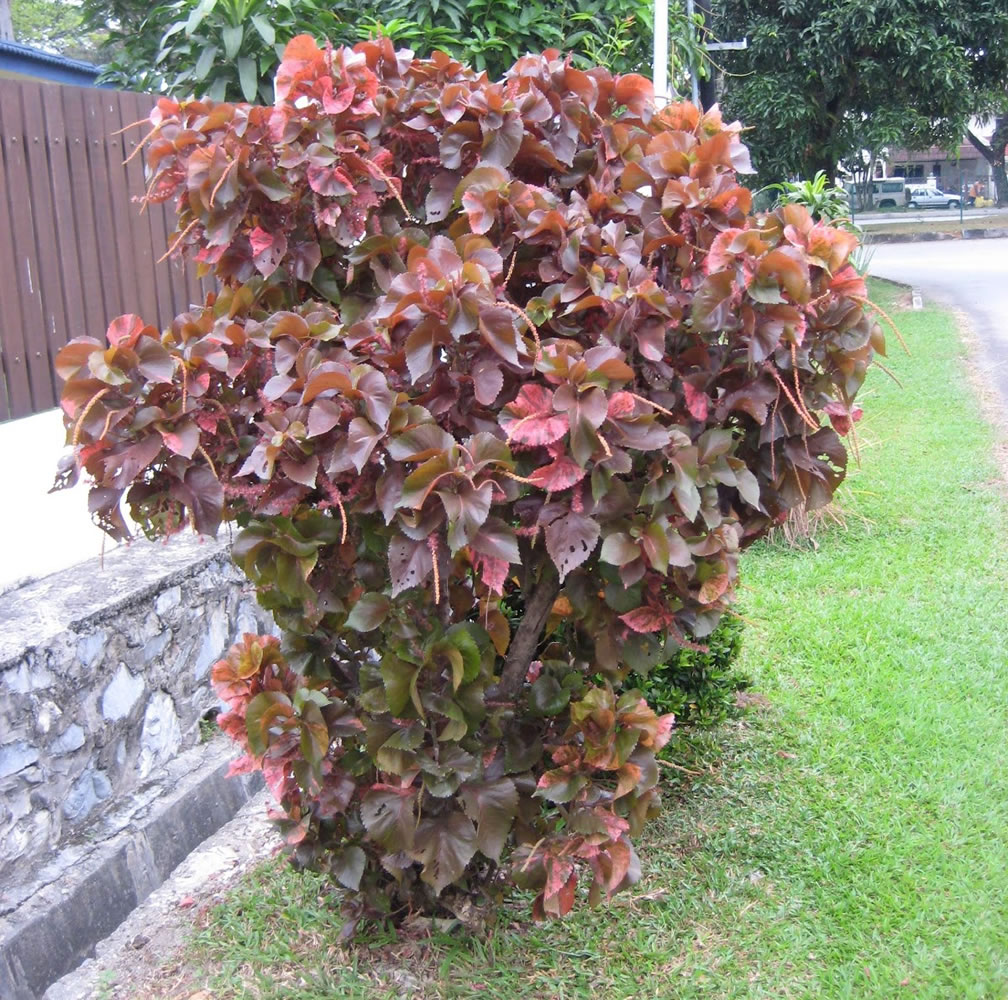 Wilks Marginata is grown as a houseplant, and where the climate allows, is widely used in landscape design
Wilks Marginata is grown as a houseplant, and where the climate allows, is widely used in landscape design
![]() Akalif bristly-playing was the first to be adapted to the unusual conditions for her, the alba selection hybrid is highlighted by the Snow-White Color Breasury at the Akalif Indian among all species, the most clearly expressed healing properties in the homeland of Acalifa South Rights as weed, it often serves as a cattle of acalifa dubberwolic acaches. Akalifa Godsefa Several Utipical Akalifa Leaves of Homesfa Division Especially Especially spectacular coloring leaves of California Akalifa, unlike most species, grows in North America
Akalif bristly-playing was the first to be adapted to the unusual conditions for her, the alba selection hybrid is highlighted by the Snow-White Color Breasury at the Akalif Indian among all species, the most clearly expressed healing properties in the homeland of Acalifa South Rights as weed, it often serves as a cattle of acalifa dubberwolic acaches. Akalifa Godsefa Several Utipical Akalifa Leaves of Homesfa Division Especially Especially spectacular coloring leaves of California Akalifa, unlike most species, grows in North America
Video: Akalifa, popular in flower water
How to provide the plant optimal conditions?
Acalifa is rather demanding on the conditions of content. It is the right microclimate that is the key to long and regular flowering.
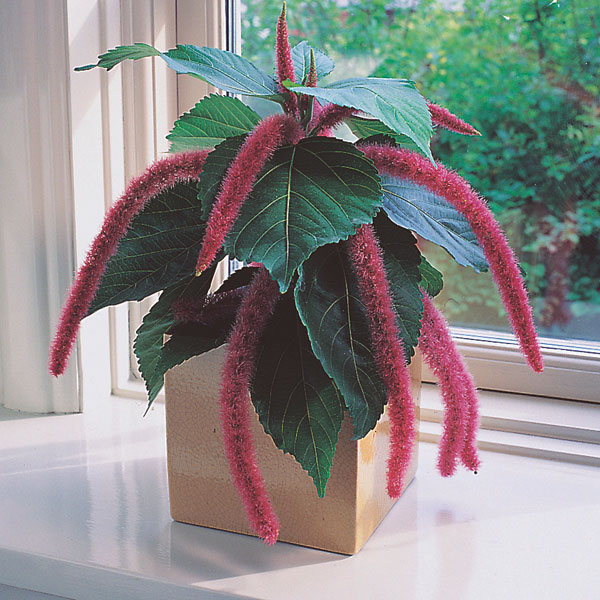 Acalifa is not a teotelubiv, but also the straight sun rays are harmful to her
Acalifa is not a teotelubiv, but also the straight sun rays are harmful to her Table: How to create an acalifor correct microclimate
| Factor | Recommendations |
| Location | The windowsill window emerging in the south-east or southwest or at some distance from the southern window. On the open air flower is not recommended, even in the summer. Necessarily regular ventilation. |
| Lighting | Need a bright but scattered light. In the period of the greatest solar activity (11: 00-14: 00), provide a plant. In winter, use special phyto or ordinary fluorescent lampsTo extend the light day at least up to 10-12 hours. The brighter the leaves from the acalifa, the more light it needs. This also applies to the birds in the shade in the shade. |
| Temperature | In the summer - 20-25ºС, in winter - 17-20ºС. At temperatures above 35ºС and below 15ºС Flower may die. The sharp drops of the temperature of the acalifa does not like cold drafts. If the optimum temperature is not obtained in winter, watering should be more frequent than during the rest. |
| Air humidity | The minimum indicator is 65% (better 70-80%). It is desirable daily (in the heat - 2-3 times a day) spray the flower and create water droplets in the air around it. In the summer, it is additionally adjusted by a water container, a wet pebble or clamzite poured into the pallet, cover the soil in a potted moss, coconut fiber. It is not necessary to pour water into the pallet - it provokes the development of rot. |
Faped Tailing and Transplanting Procedure
Akalifa under the age of 5 transplant annually at the beginning of spring. Adult plants are enough one transplant once every 2-3 years. If the flower is not physically transplant, remove the upper 3-5 cm of soil in the pot and replace it with a fresh substrate. Old acalifes often grow up, losing decorativeness, so instead of transplanting it is better to roam the cuttings.
The pot for acalifa is chosen quite wide and volumetric. The root plant system quickly masters a new space. The capacity is strongly "on the growing" - a bad option, because the growth of the above-ground part of the plant almost stops. It is advisable to choose a ceramic pot - it is more stable and gives an additional aeration.
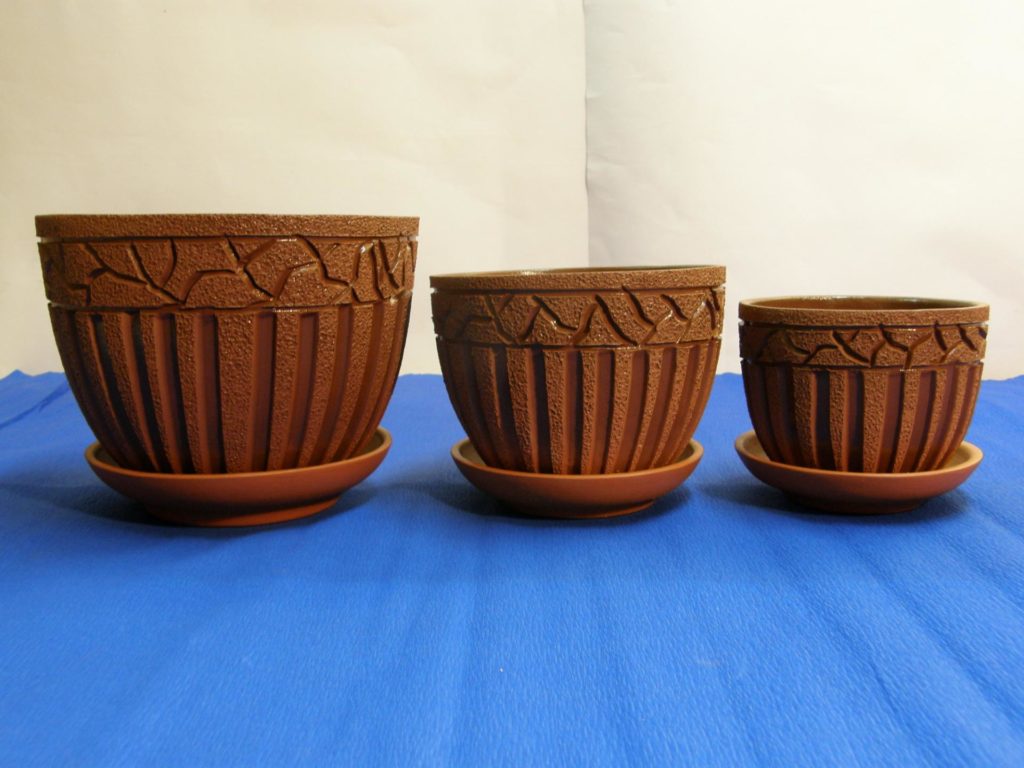 Pot for acalifes choose in size, in otherwise We'll have to wait when the roots will reveal all the new space
Pot for acalifes choose in size, in otherwise We'll have to wait when the roots will reveal all the new space
Soil for acalifes should be easy, nutritious and weakness. To obtain the necessary acid-alkaline reaction, a simple superphosphate is added to the finished substrate (10 g per 5 liters). In the absence of an alternative, the store is suitable for flowering indoor plants, but it is better to prepare a substrate independently, mixing in equal proportions. Fertile rods, universal soil for indoor flowers, leaf humus, peat crumb and large river sand.
 In prepared independently and in the store bought in the store, superphosphate is added (2 grams per 1 liter)
In prepared independently and in the store bought in the store, superphosphate is added (2 grams per 1 liter)
Transplant Acalifa - simple procedure:
- Pour a new pot to the bottom of a new pottery or other material with similar properties (layer thickness - 2-3 cm). From above - large sand, perlite or vermiculite for better water permeability.
- Fill in a freshly prepared sterilized substrate about a third of the tank.
- Pour the flower abundantly, after half an hour, remove it from the old pot, tapping along the walls.
- As far as possible, without destroying the earthen com, inspect the root system. Sharp clean knife cut dry and blackened roots. Slices Push up with an impellent chalk or activated carbon.
- Move the earthen kom to the new pot, add the soil across the edges. Carefully confuse. It is not necessary to prevent soil soil in order not to damage fragile roots.
- Moderately pour and spray the plant. For 2-3 days, remove in a light halftime.
Correct care of the room acal
Large difficulties in care if suitable conditions are created, the acalifa flower does not create. The most important thing is on time and correctly pour the plant.
Watering
Watering is the main component of the care of acalifa at home. And the disadvantage and excess of moisture will quickly destroy the plant. The soil in the pot constantly should be wet, it is impossible to give her to rear and scribe. Therefore, irrigation periodicity is determined, based on the temperature on the street and indoors. Usually enough once every 2-3 days.
Water for watering is used soft, heated to a temperature of about 30ºС. If there is no possibility to water a flower with a melt or rain water, clean the plumbing. It can be skipped through the filter, boil or let it stand for 1-2 days. To neutralize calcium compounds, chlorine and fluorine useful to add a bit apple vinegar or citric acid.
Making fertilizers
In the period of active vegetation (since the beginning of the spring until the end of September), the plant once in 12-15 days feed with any fertilizer for flowering indoor plants, using a solution according to the instructions. Organic fertilizers are not recommended, they can burn fragile roots.
Period of rest
The accilif period is clearly not expressed. It is sufficient to lower the temperature slightly, cutting a little watering (up to once in 3-5 days) and refuse feeding. The requirements for the coverage for the winter do not change, so it is desirable to rearrange the flower on the south window, not to be contacted and hosted by special lamps.
Trimming
Like most tropical plants, in suitable, the acalif grow rather rapidly, especially in height, so ugly pulls out. For greater pomp and "bush" recommended 2-3 times during the period of active growing season, pinch shoots on 1-2 top kidneys.
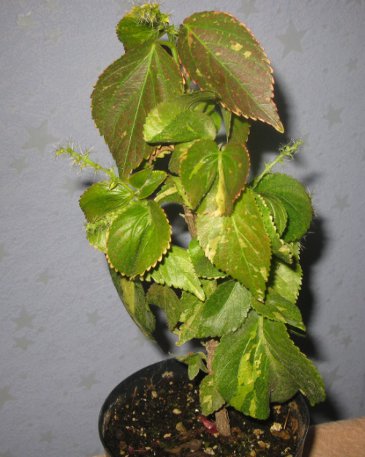 Pulling up acalifa looks not very attractive: it is enough to pinch the shoots to get a lush bush
Pulling up acalifa looks not very attractive: it is enough to pinch the shoots to get a lush bush
There is another option - annually at the end of February, to radically crop the plant, leaving about 20 cm from each escape from each escape. To stimulate growth, the flower is 3-4 times a day, they are kept on a transparent polyethylene package. It will go faster if we replace water with a weak solution of any biostimulator (topaz, zircon).
Typical bugs allowed by flower
Akalifa, followed by incorrectly, blooms much less abundant and quickly loses his decorativeness. The appearance of the plant flags about the errors made by flower water.
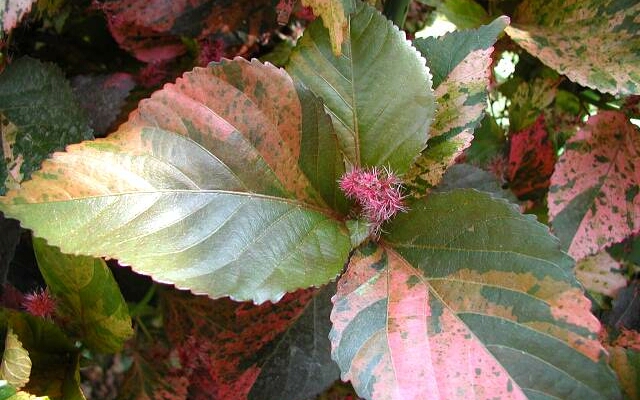 Most flower errors very quickly affects the leaf state of acalifa
Most flower errors very quickly affects the leaf state of acalifa Table: how the flower reacts to the wrong care
| What a plant looks like | What is the reason and how to solve the problem |
| The stalks are pulled out, the leaves are minced and faded. | The flower lacks light. It is necessary to find the pot of another place or use lamps. To the new terms of the Acalifa are learning gradually. |
| The leaves are yellowing, the tips are brown and dry. | Soil in the pot often dries up. To establish the right watering. |
| The leaves lose the tone, niche, the surface becomes wrinkled. | The plant is withering incorrectly. The situation described occurs during excess, and with moisture deficiency. Either "to blame" inappropriate for acalifa, too heavy, poorly transmitting soil. |
| On the leaves there are brown "wetting" spots, the bases of the cuffs and shoots are black. | The cause of the developing rot - frequent abundant watering in combination with a low temperature indoor or cold drafts. |
| Leaves dry and fall. | If the process is not too intense and affects only the bottom leaves, it is normal. Otherwise, the plant suffers from the shortage of nutrients in the soil or low air humidity. Prolocated pests |
Any specific pests affecting exclusively acalifu does not exist. Minimize the risk of sucking insects and ticks may comply with uncomplicated preventive measures:
- quarantine for newly acquired plants;
- regular ventilating room (but without cold drafts);
- inspection of household colors (better in the magnifier) \u200b\u200bat least once a week;
- maintaining comfortable for acalifa air humidity and temperature;
- proper watering and timely application of fertilizers;
- minimization of damage during transplantation, stallion, other works with a plant (use of only sterile tools, processing of all sections);
- disinfection of soil and pots;
- periodic washing plants under shower with preliminary application on the leaves of soap foam.
Table: What pests suffer from acalif
| Pest | External manifestations | How to deal? |
| Aphid | Insects will settle on the plants with colonies, bakeing the tops of the shoots, buds and the outstanding of the leaves. Plants are covered with small beige dots, well noticeable on clearance. |
|
| Bellenka | Insects, similar to the small mole, torn in the air, stands slightly just touching the flower. On the offline of the sheet - the masonry of eggs and almost colorless stains of the wrong shape. |
|
| Packers and shoots, braided thin, almost imperceptible threads. The leaf wear is covered with whiten stains, it is discolored from above. |
|
|
| Small dirty white lumps on the plant, similar to the fluff or cotton. The substrate on the edges of the pot is moving away, exposing the ring of whitic wax-like substance. |
|
|
| Red or yellow fabric sections around dull-brown oval growths; Almost black substrate. | Bellenka is experiencing a special love for yellow color; This weakness is used in the manufacture of homemade traps to combat by a paustic tick Special preparations have been developed - acaricides in particularly severe cases of the plant suffered from mathematical Cherweetseems to be sprinkled with a durable tilt shell protects it from most folk remediesthey are not always effective even as prevention
It can decorate a nipple room, transform a desert hall and easily become a special "raisy" resident of the bedroom or hallway. We are talking about an acalifa, an incredibly sympathetic representative of the Muhabny family.
Akalif flower - The leaving of the tropics, acts on the Islands of Fiji, Polynesia, in Australia and other hot countries. You probably already understood that the plant we chose a rather capricious, in leaving for which you will have to sweat!
By the way, if you are the lion on the horoscope, then the flower of the acalif is for you for you! You can put it on the windowsill, but can be used as ampel plant. The brightest representatives of the kind - Akalifa forks and Akalif Wilx.
Acalifa - care at home
In the wild increase, this flower in height can grow to three meters, well, in bedroom flowering, it is somewhat lower. The main highlight of this plant is of course, its hanging inflorescences of a saturated raspberry-red shade. The foliage is mostly green, there are also bronze or orange strokes.
Important! Akalifa is a poisonous plant!
So that she grew up and pleased her beautiful blossom, she needs a lot of light and a lot of heat. Take care of the plant from drafts, do not wear it outside, if you do not live in her native climate in the region.
Priming. The soil for acalifa is suitable mixed from the turf, coniferous and leaf land, you can still add a little overwhelmed manure. But at the same time the soil should remain light, air and water permeable.
Lighting. As we have already written above, it is necessary to cover the acalifu. That is, until the middle of the summer it will be suitable for her, and in the midst of the open sun take her. It is thanks to the lighting flower of an acalifa will be so blooming, what you see it in the photo.
Temperature. Heat and warmly warm. No cold in the house. In winter, it will be at a minimum of +18 in the degrees, and in the summer days - hold the temperature from +20.
Humidity. The flower of acalifa loves moisture, remember - this is a resident of the tropics and subtropics. On a regular basis spray the plant. Dry air it does not take place.
Watering. For the summer, we water the acalifu very abundantly, we turn to the moderate mode in winter. Water should be soft, you can use water softener from the brand "Floral Happiness". The soil in the pot always has to be wet, but do not stuff water - it's bad. It is worth remembering the drainage when landing acalifes.
Landing / transplanting. Plant and transplant acalifu in the spring. The transplant can be carried out every few years until the flower grows up to large sizes. A large plant is better not to replant, but simply remove the old top layer of the soil and replace the new one. When landing, Akalifa needs a good drainage, because the plant loves abundant irrigation, and water stagnation - does not like.
Feeding. It can be supported by an acalifu by organic and mineral fertilizers for decorative-flowering plants, such in the Floor Happiness, "FASTA" and "POKON". Cutting in spring and summer every two weeks.
Reproduction. The reproduction of acalifes falls on the spring, just when transplanting can take care of this. Shining is the best method. The top acales of acalifes root in the heated ground (+ 20 + 22 degrees), cover with glass or transparent film, put it in heat. Young shoots can be segged to stimulate their branching. I would like to remind you that the acalifa of poisonous and all work should be taken carefully and in gloves. Well, and, of course, the acalifa and seeds are breeding, which plant in the spring to homemade greenhouse and germinate, you can with the lower heated.
Trimming. Repeat gloves again, take the scissors and begin to pruning acalifes. Such events are required when the flower starts to lose attractiveness, it will look just a shapeless bunch of leaves and colors. Then we cut our lisus tail up to 20 centimeters, yes, it is ruthless, but it is worth it, otherwise the plant will just grow and stitch and not in breadth ... After trimming, we put on the leaked Prenethylene Polyethylene and coat the glass cap (bank, bowl, plander - what worse). This will help acalifer to survive trimming stress.
At the same time, new shoots will not eat and will not heal old, periodically remove the entire design with acalifes and spray the plant with such a solution: 2 drop of zircon on one liter of water. This will help the plant adapt to its new hairstyle.
Types and varieties of acalifa
In the nature of the acalifa about 450 small evergreen shrubs separated by 2 groups: decorative and blooming and decorative-deciduous, the most famous and cultivated are:

Acalifa forks. The decorative deciduous plant is grown for the sake of beautiful large bronze-green leaves in size 20x15 cm. The flowers for this species are completely unpleasant and small. To the height to reach a plant can be up to 300 cm. There are different varieties of this type of acalifa, for example: marginat, mosaic and GodSefofiana.
Acalifa Haitianskaya. This is exactly the species that is grown at home as an ampel plant. Also called acalifa destruction. Light-green foliage, gear. The inflorescences are pubescent, bright red with a raspberry tinge, drooping, length 3-10 cm. On the care of this type of acalifes, we wrote above.
Akalifa bristly streams. Decorative-blossoming, with long hanging inflorescences up to 50 cm long. Raspberry-red flowers, there are variety Alba, whose flowers are white. The height of the acalifes of bristle-resistant is also about 300 cm.
Akalif Indian. A small one-year shrub, the height is only 50 cm, a foliage of a green color, similar to nettle. Blossom comes in July, inland flowers.
Akalif South. Nice annual with stubby inflorescences. Size 50 cm, Flowers are small and not very attractive.
Akalifa Godsef. Hybrid with widespread pointed leaves of bronze-green color with Mahamon Kant.
Akalif is a flowering plant, which in everyday life is called "Film Tail". However, this name can be fully attributed only to one of the species of the plant, namely to the acalifa bristle-sided. Only his elongated raspberry inflorescences resemble a little fox tail. This variety of flower is the most common among flower water.
Another type of plants, often occurring on the windowsill, is Wilx Acalifa or a forks. Although flowers from this type of plant are not so attractive as the previous variety, but the leaves have a magnificent color. For growing acalifa at home there are all advantages. It grows rapidly and does not require special attention. A varied at first glances, the types of acalifes are the same in care.
Temperature mode
The plant is thermal-loving and extremely negatively to treat drafts. If you plan to endure a flower in the summer on a balcony or an open veranda, then it should be protected from through blowing. A draft can destroy the plant. An acceptable air temperature in the summer for acalifa is 20-25 degrees. In winter, satisfactory temperatures are considered not lower than +18 degrees. Ideal temperature conditions for the flower, this is the temperature of the closed room.
Necessary lighting
Many light and sun shaders are exactly what the flower needs. With insufficient lighting, the plant will stretch, and the leaves will sweep. It ruins appearance Acalifes.
Watering mode
Acalifa moisture-loving plant. In the summer, when the air temperature exceeds 20 degrees, it is recommended to water a lot and often. In winter, watering must be slightly cut. But it is impossible to allow soil cutting in a pot.
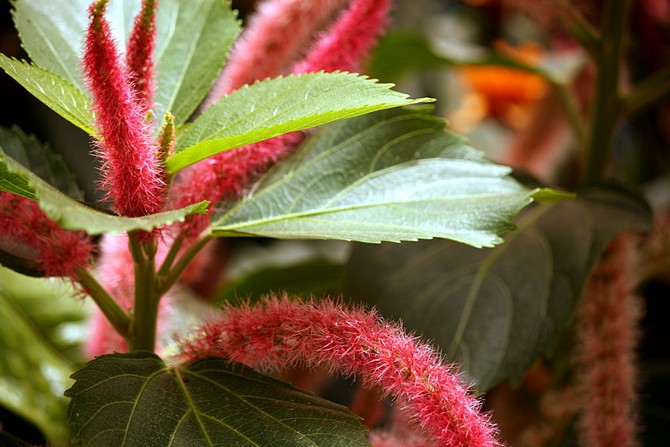
Does not like a plant and dry air. In the hot period of time, the flower must be sprayed. In order for the air around the plant always remained wet, the pot with acalifa put on the pallet and pour pebbles or clamzit on it. Moisturizing pallet with filler, thereby moisturize the air around the plant.
Falker Plants
From spring and ending in autumn, mineral fertilizers contribute to the pot with a plant, the concentration of which is 0.1-0.2%. The feeder is made every 15 days. In winter, the feeding is usually stopped.
Transfer
If the plant is young, then it is transplanted annually. In the future, the transplant is made once every 3-4 years. But based on the practice, a fast-growing plant for such a long time is greatly growing and becomes not beautiful, so it will be in need of transplantation, pruning and updating. Often, it makes sense to grow another plant, younger than to transplant the old, who has lost its charm.
Transplanted plant in spring. For soil there is one condition. It should be easy to skip water and air. The planting soil can be purchased in the store, and you can do it yourself. To do this, it is necessary to mix on one part of the turf, leaf land, humid, peat and sand.
Trimming
If your plant is an adult, then this moment of time is suitable when it creates a lot and will need trimming. If your old plant is expensive to you, or you do not want to grow new, then it is necessary to cut the plant to the state of hemp, about 20 and centimeter height. Although this measure will seem somewhat cruel, but it is necessary to do this.
Next, it is possible to wear a polyethylene film on the pennies and placed under a glass cap. Such measures will help the plant to give new shoots and survive the ruthless operation. The cropped plant must often spray and ventilate, periodically removing the design from the package and banks. Nice results To adapt the plant gives a spraying with an aqueous zircon solution at the rate of 2 drops of the drug per 1 liter of water.
Reproduction
In order to multiply flower, you will not need any special skills. Acalifa can be multiplied with either cuttings or seeds. For seeds, you can apply a mixture of sand and leaf land, in proportion 1: 1. Seeds are sized in spring. For their successful germination, it is necessary to ensure temperature regime in the area of \u200b\u200b20 degrees. To speed up the germination of seeds, you can build a little greenhouse over the container and provide him with lower heating.

The reproduction of acalifes with cuttings is an even simpler process. For rooting, soil from sand and peat mixed in equal proportion is suitable. For cuttings, wood processes from the top of the plant are selected. It is believed to roof the cuttings can be year-round. But the "fox", the cuttings are better leaving in the spring. Before the landing, the material will dip in the stimulator for the roots and is covered with a film from above. After 2 months, the plant is plugged for greater bushes.
Acalifa refers to poisonous plants. When contacting it, care should be taken, and wear gloves. Communication of the plant with children and domestic animals should be limited.
Motherland flower Acalifes - Tropical forests of South Asia, as well as the islands of the Pacific Ocean.
Name This plant comes from ancient Greek "nettle" due to the similarity of the form of their leaves.
Blossom Acalifa accompanied by the appearance of lush inflorescences that hang down.
Because of this, the plant is sometimes called the "fox".
Types of acalifes
At home, 2 types of this plant are grown:
Akalif Wilksa (Acalypha Wilkesiana). It has bronze-green leaves with stains forming curious drawings. The leaves are pointed, with gear edges, up to 25 cm long. Inflorescences do not exceed 10 cm long.
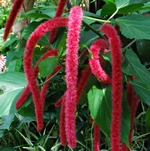 Acalifa bristle (Acalypha Hispida). This type of inflorescences are very long, reach 50 cm, bright shades, usually brightly raspberry. One plant may contain 20-30 inflorescences.
Acalifa bristle (Acalypha Hispida). This type of inflorescences are very long, reach 50 cm, bright shades, usually brightly raspberry. One plant may contain 20-30 inflorescences.
Care for acalifa
Acalifa care at home involves the creation of a complex of conditions for its comfortable growing in your garden. To do this, it is necessary to choose the necessary lighting, humidity, temperature, pick up the feeding, so that the window is blocked by a motley fox tail.
Lighting
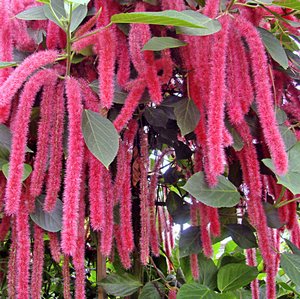 Bedroom acalifa prefers Intense light, but it is necessary to protect her leaves from the straight rays of the sun.
Bedroom acalifa prefers Intense light, but it is necessary to protect her leaves from the straight rays of the sun.
Bright light Must fall on a plant for at least 16 hours a day.
If natural light sources are not enough, artificial lighting will have to organize.
Temperature and humidity
During the actual growth phase perfect temperature For acalifa will be +25 degrees. In the winter months, the room should not be colder than +18 degrees.
Humidity The air is required high. You need to often spray acalifu, but you can put a pot on gravel, which should be moistened daily.
Watering the plant acalifes in the summer is needed twice a week, and in the winter - at least once every 10 days.
Need to be careful Plant Akalifa from the conjunction.
Undercalinking and transplant
In the summer and in the spring, when the acalif is in the phase of intensive growth, it is required to fertilize at least two times a month, using mineral fertilizers. In the winter months, the plant in the feeder does not need.
The transplant acalifa is carried out in the spring. It takes a pot of not very large size. Soil prepare From the mixture in equal parts:
- humus;
- sand;
- turf;
- peat.
Do not forget to put a good pot on the bottom.
Reproduction of acalifes
 Split This plant is two ways - seeds and stalling. Reproduction with cuttings.
Split This plant is two ways - seeds and stalling. Reproduction with cuttings.
At the beginning of autumn top shoots Acalifa is cut into 10 centimeter cuttings, then they are placed in the sand.
Capacity With cuttings, it is necessary to contain in the warm room, the temperature of which will not fall below +22 degrees. Sand needs to often moisturize.
Reproduction of seeds. Held in the middle of spring. Seeds need to be sown in the sand with the addition of leaf land. The temperature and humidity maintain the same as in the reproduction of cuttings. When the seeds are sprouting, they must be signed in small pots.
Diseases and pests Acalifa
When violating the rules of care of acalifa, the plant can please the following painful features.
- Fall yellow leaves - Little moisture or too cold indoors.
- The plant stretches up - Lack of light.
- Spots on the leaves - damage to fungus. Fungicide treatment is required.
- Slow Rost., Pale leaves are not enough fertilizer.
Akalif pests are, trips and troubles. Measures to combat them - the use of insecticides or famous folk remedies.
And lovers know more, we suggest familiarize yourself with the video about Akalifa or Fierce Tail
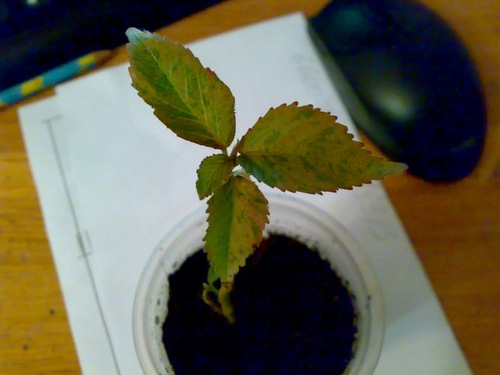 Stretched seeding need to transplant in more nutritious soil
Stretched seeding need to transplant in more nutritious soil
 The rooted cuttings of acalifa are pretty quickly added in growth.
The rooted cuttings of acalifa are pretty quickly added in growth. 

